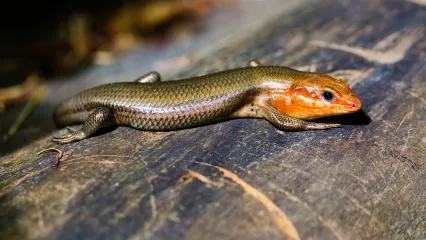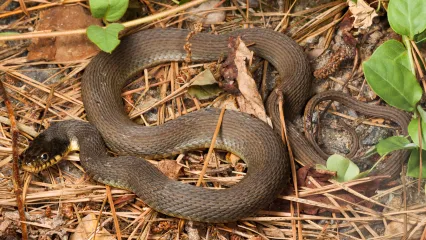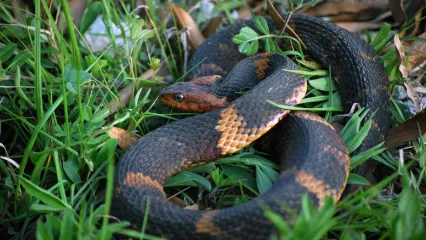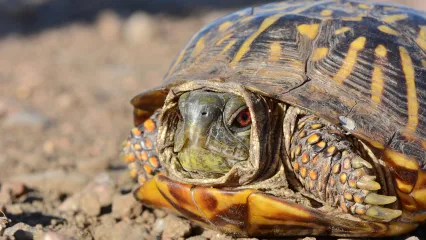
Description
Broad-headed skinks are relatively large lizards with smooth, glass-like scales, well-developed limbs, and a tail that is slightly longer than the body. Juveniles are black with five distinct white stripes extending from the head to the first one-third of the tail. As these skinks age, the stripes become less well-defined, the background coloration fades to brown or tan, and when sexual maturity is reached, the blue tails fade, with blue coloration disappearing completely within about a year following attainment of sexual maturity. Large adult males lost the stripes completely and have a brown-tan body and tail. Adult females retain the stripes, but their colors are faded compared with juveniles. A combination of size, coloration, and scale characteristics distinguish broad-headed skinks from other skinks. Small black skinks with five white stripes and brilliant blue tails can only be broad-headed skinks or five-lined skinks. These two species can be distinguished as juveniles by counting the upper labial scales – broad-headed skinks have nine, with no post-labials whereas five-lined skins have seven with two post-labials. In addition, the sixth upper labial is the first to contact the orbit of the eye in broad-headed skinks whereas the fifth upper labial is the first to contact the orbit of the eye in five-lined skinks. Although the distinctive striping fades and even disappears in large adults, adults can easily be distinguished from all other skinks by size and coloration. Great Plains skinks can easily be distinguished from broad-headed skinks because their background coloration is tan to yellow, and each scale is bordered by black, giving the impression that the skink has eleven irregular narrow stripes.
Size
Large adult broad-headed skinks can reach 5 ½ inches in snout to vent length and about 12 inches in total length. Males are larger than females and have relatively larger heads. They are the second largest skink in Oklahoma, exceeded only by the Great Plains skink, which does not occur in forests of eastern Oklahoma (but does occur in western Oklahoma and some patches of prairie in central and eastern Oklahoma). Many individuals have regenerated tails so that the ratio of tail to body length is reduced.
Habitat
In North America, the west-east distribution of broad-headed skinks extends from eastern Oklahoma and Texas to extreme southern Pennsylvania and north-south from southern Indiana and Ohio to the Atlantic Gulf Coast, including the northern half of peninsular Florida.
Life Cycle
Broad-headed skinks are strictly diurnal and are usually associated with hardwood forests. Juveniles can be active on sunny days as early as March, but most activity of adults and juveniles occurs from April through November, depending on local climatic conditions. Mating occurs from May through June. During the mating season, heads of males turn bright red or orange as a result of hormonal changes associated with breeding. Males interact aggressively while courting females, and courtship behavior involves following a female for a prolonged time period prior to mating. Females deposit clutches of eggs varying from as few as 7 to more than 20 eggs in June and July. The number of eggs produced by females depends on size of the female; larger females produce more eggs than smaller females. Females construct nests as hollowed out areas, usually under hardwood logs or in rotted areas of hardwood logs under bark, but occasionally under rocks. The nests are often associated with areas in the logs where passalid beetles (also called “bessbugs”) have hollowed out the area. Females push rotted hardwood material against the side of the nest chambers by moving in a circular motion. Once the nest is constructed the female lays the eggs, coils around them, and remains with the eggs until they hatch. Females frequently reposition the eggs, and sometimes leave the nest to feed. Respiratory water loss from the female helps to maintain the moisture in the nest necessary to maintain the developing embryos. Eggs hatch from late July through early September, and hatchlings are about 1.3 inches in snout-vent length, with the tail slightly longer than the body. No post-hatching parental care exists. Eggs within a nest hatch nearly synchronously, and both the female and the hatchlings abandon the nest when hatching occurs. Broad-headed skinks are capable of living at least five years, and likely longer. Sexual maturity is reached during the second year following hatching. Broad-headed skinks feed primarily on invertebrates, including a wide variety of insects and spiders. Although they eat most species of wasps and bees, they avoid velvet ants. Similar to other skinks, broad-headed skinks use chemical cues to determine sex and reproductive status during social interactions and to discriminate prey. They avoid insects that produce chemicals for defense, such as many ants and beetles. The brightly-colored tails of juveniles are easily lost. Juveniles often flick the tail around when they bury their heads in leaf litter searching for prey. This behavior appears to distract birds and other potential predators away from the skink’s body and to the tail. Juveniles can regenerate their tails in about five weeks. When broad-headed skinks reach sexual maturity, the tails lose their brilliant blue coloration and they are not as easily lost. Tails contain a large amount of stored energy, and if a female loses its tail during the breeding season, the loss of stored energy can reduce clutch size. Contrary to popular belief, tails are not pulled off by predators, rather, the lizard initiates release of the tail, a process known as “tail autotomy [self loss].”
How To Observe
Broad-headed skinks are difficult to observe in the field even though they may be common. During the spring breeding season, males engage in often-fierce social interactions with other males, and by waiting patiently and not moving in forested areas where they occur, they can be easily observed. In the western part of their range, these skinks are highly secretive and seek retreats when an observer moves around. Juveniles, which closely resemble juveniles of five-lined skins, can often be observed climbing on logs and trunks of trees in late summer and early fall.
(This profile was created by Dr. Laurie Vitt as part of a partnership between the Wildlife Department and the Sam Noble Oklahoma Museum of Natural History. It was funded as part of a larger State Wildlife Grant to survey and inventory amphibians and reptiles of the Wildlife Management Areas of Oklahoma: T-35-P-1.)


